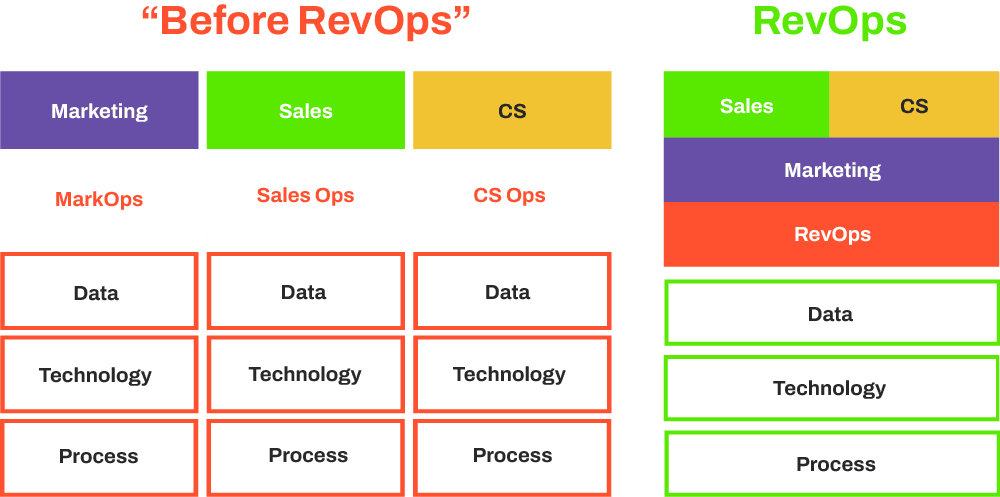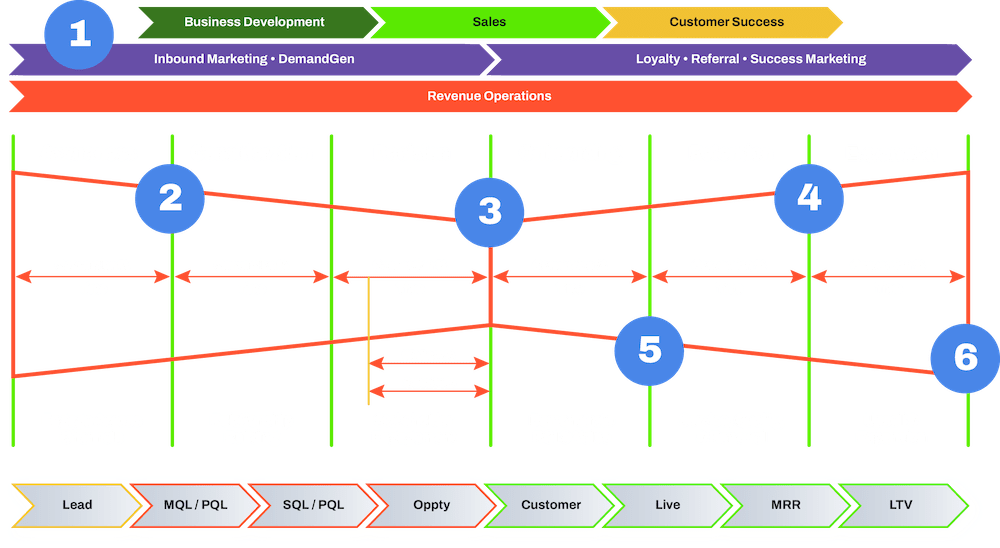Revenue Operations (or RevOps) has become a popular concept and title over the past couple of years. But despite its widespread use—we still get a lot of questions surrounding RevOps.
So let’s take just a few minutes to dive into the most frequently asked RevOps questions:
What exactly is RevOps? (And why is it important?)
RevOps is just a fancy way of referring to a more modern and efficient approach of aligning your GTM operations teams, processes, and systems. (or you may want to remember it with the 3Ps (People, Processes, Platforms.. We like to also add Data here)
For years, as organizations grew organically, each GTM team (i.e. Sales, Service, Marketing) needed their own ops and implementation teams to manage tech stack and operations. Each department developed structures and ops teams to support their specific function. This helps with efficiency for that department’s short term needs but, in the long term, also reinforces departmental silos and organization-wide inefficiencies.
RevOps seeks to align all of the operations and change management functions of your GTM teams (i.e. Sales, Marketing, Service, Finance) under one roof—with an understanding of all department’s goals and needs to promote transparency, efficiency, and results.
This means decisions and implementation of your tech stack, processes and adoption, as well as data and reporting that they produce.

How does RevOps differ from “traditional” Ops?
RevOps is not simply Sales Ops or Marketing Ops (e.g. list building, marketing automation). Yes—RevOps may include some of those activities but it also seeks to elevate the ops role to ensure that all revenue activities are aligned with an organization’s top-level KPIs and goals.
Automation for automation sake—or attempting to build processes for a single department without an awareness of the “complete picture” often leads to undesired outcomes and misses key goals.
An effective RevOps team understands the importance of building, managing, and ensuring the adoption of a healthy and “complete” revenue engine for all teams.
Why should your RevOps Squad be "in charge" of your CRM?
Your CRM will be one of the most expensive and valuable databases for your business in terms of customer data and supporting your GTM teams. RevOps professionals are focused on ensuring adoption of those systems—AND—that the processes codified within them are producing meaningful, actionable data.
This means your entire Customer Journey and how your teams align and support one another. (see image)

Modern organizations build RevOps functions to ensure that the entire customer journey and every hand-off stage between conversions or teams are measured and improved—translating to significant improvements to both efficiency AND your bottom line.
When should we start investing in RevOps?
The answer to that question will vary based on a number of factors. Industry, Product/Service/Growth Model, Team Size, Revenue, etc.
Generally speaking though—we believe B2B organizations beyond $5M in revenue (certainly by $10M, some as early as $2M) should be thinking about optimizing systems, processes, and the way they grow their teams.
Sales reps and "people hours" will significantly impact your profitability and are one—if not THE—largest expense in your Customer Acquisition Cost (CAC). Gone are the days where "throwing bodies at problems" will produce results.
RevOps experts will not only ensure systems are built and running smoothly, but that processes are effective, producing data, and helping you solve for future growth challenges.
Okay, I think I understand RevOps—but how do we get started?
The good news is that you’re already on the right track! But RevOps, like your CRM or other meaningful tools cannot be treated like a one-time project.
Success is built on the foundations of transparency, continuous improvement, and a commitment to training and adoption.
If you’re just getting started with RevOps—here are a few questions and topics you might explore:
- Have you mapped your customer journey and lifecycle requirements?
- Have you clearly defined requirements for each of your customer lifecycle stages?
- Have you identified AND are you continuously refining your department hands-offs? (i.e. Marketing to Sales, Sales to Success)
- Have you clearly defined your departmental and organizational KPIs/Goals?
- Do you know where your biggest opportunities/gaps are?
- Are you investing in continuous learning, process adoption, and system refinement (feature releases for internal GTM teams) to produce better data?
Those should get you started. If you’re looking for actionable RevOps projects to get started—check out the Resources section on our website, subscribe to our newsletter, or even request a HubSpot Audit!